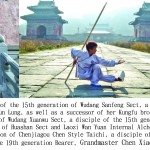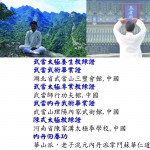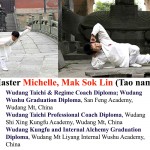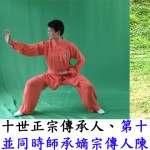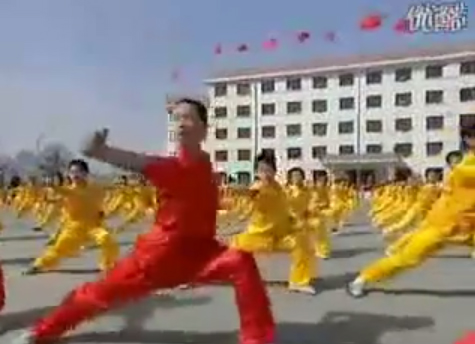中國武術段位制
視頻介紹
| 中國武術段位制技術體系簡介(中英) |
| 日期:2011-07-01 來源:武網 作者:武網 |
|
中國武術段位制技術體系簡介 Introduction to Chinese Wushu Duanwei Technical System 《中國武術段位制》是中國武術協會制定的一項評價習武者武術水平的等級制度。以此為依據編寫的《中國武術段位制系列教程》(以下簡稱“本系列教程”),旨在完備《中國武術段位制》的考評內容和等級標準。力求通過標準化段位技術體系的建立,推動武術運動廣泛普及,促進武術流派百花齊放,引導習武者通過逐級晉段,循序漸進地了解和掌握武術知識體系和拳、械技術,達到科學鍛煉身體的目的。 The Chinese Wushu Duanwei System is a hierarchical system which the Chinese Wushu Association formulated to evaluate the professional level of wushu players and learners. Based on this system, the Textbook Series of Chinese Wushu Duanwei System (hereafter referred to as the Textbook Series) has been compiled to improve and perfect the evaluation targets and level standards of the Duanwei System. In order to promote the popularization of Wushu and develop different schools, the Association has made every effort to establish a standard Duanwei technical system, which will guide wushu learners to master wushu and its empty hand and weapon techniques following gradual improvement and promotion through Duan levels. 《中國武術段位制》的考評內容包括武德與武術禮儀、理論知識、技術技能3個方面。對高段位申報者,還要考評他們在武術理論方面的建樹和對武術發展的貢獻。緣此,本系列教程確定了《武德與武術禮儀》《中國武術史》《武術概論》3冊理論教程和一冊《中國武術段位制理論考試題解》;選編了長拳、少林拳、太極拳(陳、楊、吳、武、孫、和)、形意拳、八卦掌、通臂拳、戳腳、翻子拳、八極拳、螳螂拳、五祖拳、詠春拳12個拳種的17冊教程,以及不受拳種限制的《趣味武術(段前級教程)》《武術功法》《自衛防身術》和《劍術》《短棍》《二節棍》3種器械教程。 The evaluation targets of the Chinese Wushu Duanwei System embrace wushu ethics and etiquette, theories, techniques and skills. The evaluation targets for applicants for high Duanwei levels include their achievements in wushu theories and their contributions to the development of wushu. Therefore, the Textbook Series consists of the following course books:3 theory textbooks including Wushu Ethics and Etiquette, The History of Chinese Wushu and Introduction to Chinese Wushu; Chinese Wushu Duanwei System Examination: Problems and Solutions; 17 textbooks embracing 12 styles including Changquan, Shaolinquan, Taijiquan(Chen-style,Yang-style,Wu-style,Wuu-style,Sun-style,He-style), Xingyiquan, Baguazhang, Tongbiquan, Chuojiao, Fanziquan, Bajiquan, Tanglangquan, Wuzuquan, Yongchunquan, Wushu for Fun (pre-duan Textbook), Wushu Gongfa, Wushu Self -defense and three weapon courses including Jianshu, Duangun, Erjiegun. 《中國武術段位制》將習練武術的水平,由低到高分為段前級(一至三級)、初段位(一至三段)、中段位(四至六段)、高段位(七至九段)。一定的段位等級,通過一定的標準來界定。因此,制定統一的考評標準,明確不同段級間的標準差異是這套系列教程的重點。在製定統一的技術標準方面,我們依據武術發展的內在規律,將 “既可單練、又可對打、還能實戰”的傳統武術演練形式,確立為技術內容的結構標準。即每段技術內容的單練套路既能單練,拆分後又能進行對打套路的練習,還能以拆招形式體現實戰技法,突出了傳統武術“練打結合”的特色,體現了武術以攻防動作為運動素材和健身手段的本質,使習練者既掌握動作的操練方法,又懂得動作的攻防含義。 According to the Chinese Wushu Duanwei System, the professional levels of players can be graded from low to high levels as follows: primary Duan (levels 1~3), middle Duan (4th~6th Duan) and advanced Duan (7th~9th Duan). There is also a pre-duan System which has three levels. The Duan level should follow a corresponding standard, therefore, formulating a unified evaluating standard and distinguishing standards for different levels is the focal points of the Textbook Series. When formulating the unified technical standard, we establish the traditional practice form for singe practice, dual combat and real-world application, as the structure of the technical content. Each level has its own form. Each form can be used firstly as solo practice, next as choreographed fighting with a partner, and finally each move in the form can be studied for its real-world martial application. This progression follows the methods of traditional wushu training which combines practice and fighting. It embodies the essence of wushu. The practitioner can master the techniques and understand their meaning. 為了明確不同段時間的差異,本系列教程按照循序漸進、系統學習的原則,從技術元素、動作數量和難度3個方面進行了規範。 In order to clarify the differences between Duan levels, the Textbook Series standardizes the levels in respect to the technical elements, total number of movements and degree of difficulty, always following the principle of gradual and systematic study. 其一,以增加技術元素提高段級的標準。本套系列教程圍繞武術各拳種、器械均包含的“打、踢、拿、靠、摔”5類技術元素,通過逐段增加新技術元素的方式,明確了一至五段技術內容,第六段技術內容是對上述5類技術元素的綜合運用。例如,一段技術只有“打”的攻防方法;二段技術增加“踢”的攻防方法……依此類推,具體如下表所示: First, the standard at each level increases by the addition of more technical elements. Five technical elements including “punch, kick, grasp, position,wrestle” are embodied in all schools of styles and weapons. The Textbook Series defines the technical content of the first five Duan levels by increasing technical element level by level. The technical content of the 6th Duan is a comprehensive application of the five technical elements mentioned above. For example, “punch” is the only technique of attack and defense in the 1st Duan; in the 2nd Duan, “kick” is added. The rest may be deduced by analogy as follows:
其二,以增加動作數量提高段級的標準。即在逐段增加技術元素的同時,循序漸進地增加動作數量。 Secondly, the total number of movements increases at each level. This is done to complement the increased number of techniques being added. 其三,以加大動作難度提高段級的標準。即同一技術元素在由低到高的段級中,是通過由基礎到衍生、由簡易到繁難的順序來表現的。例如,“打”是武術運動中最為基本、簡易和被廣泛使用的技術元素,被列為一段技術內容,同時也是二至六段的技術內容。而“打”的技術有“衝、劈、推、撩、托、蓋”等多種表現形式和向左、右、前、後等不同方位,按照從基礎到衍生、從簡易到繁難的順序,依次分為6份,分別編入一至六段。這樣,通過變換技術元素的表現形式、加大單個動作(或組合動作)的難度,從整體上逐漸提高一至六段技術的難度。 Thirdly, the degree of difficulty of the movements is steadily increased. For instance, “punch” is the simplest and most widely used technical element in Wushu. It is a common technical element in all six Duans. However, the manifestations of “punch” includes the straight punch, cutting strike, push, upward cut, upward push, and downward swing punch in four directions. We grade these movements from simple to complicated and divide them into six levels. In this way different degrees of difficulty are added to each movement as the level increases. 《趣味武術(段前級教程)》《武術功法》和《自衛防身術》的段級技術內容同樣遵循上述原則編定,既保證了本系列教程體例的統一,也保證了不同拳種教程同一段級的技術借鑒和技能互補。 The technical content of Wushu for Fun(pre-Duan Textbook), Wushu Gongfa and Wushu Self-defense are also compiled in accordance with the above principles, which ensures a unity of style and a consistency between different styles and texbooks of the same Duan level. 按照逐段增加技術元素、動作數量和難度製定出的段位標準,不僅便於習練者明確段級間的差異;而且,隨著段級的晉升,會逐步掌握所習拳種的技術體系,體現了循序漸進、系統學習的原則;還能有效避免學習內容掛一漏萬、簡單重複等問題。此外,由於這套系列教程均按此體例編寫,就學習武術的基本技術元素而言,習練者不論練習哪個拳種,學習進度都是一致的,在達到某一個拳種的段位水平後,可以轉學另一拳種的高一級別段位技術。 The Duan level standards are set according to the principle of gradually increasing the technical elements and the total number and difficulty of the movements level by level. This means that learners can easily distinguish the difference between each Duan level, and after being promoted to a higher Duan level, the players can master the technical system of the styles learned. In addition, because the Tutorial Series is compiled with this unified style, regardless of what styles one is learning, the learning progress is the same, which means that after a learner reaches a certain Duan level of one style, he can transfer to another style for a higher level. 《中國武術段位制》考評內容的標準化和規範化,為順利實施《中國武術段位制》標準化考試奠定了基礎,有助於武術的發展和在國內外的廣泛傳播。此外,標準化還是多樣化的基礎。 20世紀50年代,由中國武術協會組編的二十四式簡化太極拳,拉開了各式傳統太極拳全面發展的序幕,是標準化帶動武術流派百花齊放的突出例證。 The standardization of the evaluation targets of the Chinese Wushu Duanwei System lays the foundation for a smooth implementation of its standardized exam, and also contributes to the development of wushu and its spread at home and abroad. In addition, standardization is a basis for diversification. In the 1950s the 24 Simplified Taiqiquan was compiled by the Chinese Wushu Association and started the all-around development of Taijiquan in its different styles. This is a prominent example showing that standardization could lead to the flourishing of all schools of wushu. 本系列教程是根據2007年10月召開的“全國武術段位制工作會議”關於“段位評定從套段轉入考段”的會議決議啟動編寫的。 2008年,國家體育總局武術研究院相繼聘請了一百多位有代表性的民間武術傳人和專家、學者,啟動了段位考評內容的創編和配套教程的編寫工作。 2008年7月,本系列教程通過中國武術協會的審定。評審委員會認為:“《中國武術段位制系列教程》編寫目的明確,體例得當,體現了傳統性和時代性,段級標準與技術難度適宜,技術規範,拳種和器械風格突出,是一部學術性、代表性、可行性都值得肯定的作品,達到了發布實施的標準。”隨後,編寫人員又按照內容符合體例、圖解符合規範的要求進行加工,再經專家審稿、出版編輯的加工才正式攝製教學片、拍攝技術圖片、合成書稿。應該說,這套集眾多傳人和專家、學者的學識和智慧創編而成的系列教程,是一部將《中國武術段位制》的實施與繼承、傳播武術融為一體的精心之作。當然,對於這項嶄新的系統工程而言,由於組織者、參編者業務水平的局限,不當之處在所難免,敬請讀者指正。 The compiling of the series of this course is based on the resolutions made at the National Wushu Duanwei Work Conference in October 2007, which was chiefly concerned with the shifting of Duan evaluation to a more graded testing system. In 2008, the Wushu Research Institute of the General Administration of Sport of China employed a succession of more than 100 representatives of folk Wushu, experts and scholars and launched the evaluation of the Duanwei System and the compiling of the corresponding courses. In July, 2008, the courses were examined by the Chinese Wushu Association, whose assessment committee validated it to be academic, representative and feasible. It met the standards of promulgation as it was equipped with specific targets and proper style, reflecting the tradition and proper Duan standards, technical difficulty, standard specification as well as prominent styles and weapons. It was processed by the compilers on the basis that the content should agree with the style while the diagrams should meet the specified standards. After being drafted by the experts and processed by publishing editors, the teaching films were formally produced, the technical pictures shot, and the manuscripts published. This series of courses was composed by adopting the knowledge and wisdom of a great number of experts and scholars, and is a masterpiece which combines the implementation and inheritance of Chinese Wushu Duanwei System with the spreading of Wushu. As far as this brand-new project is concerned, we apologise for any inevitable mistakes that may have appeared due to our own lack of expertise. Criticism from the readers is welcomed. 這本《八卦掌》是《中國武術段位制系列教程》中的一種。本書在編寫過程中得到了高繼武、郭振亞、王尚智、任文柱、文大生先生的誠摯支持,特此致謝! This Baguazhang is the one of the series. Sincere support has been obtained from Gao Jiwu, Guo Zhenya, Wang Shangzhu, Ren Wenzhu, Wen Dasheng. We extend our thanks to them. 國家體育總局武術研究院 二〇〇九年二月 Wushu Research Institute of the General Administration of Sport of China February, 2009 |
資料來源: http://www.gzvs.cn/html/2011/07/01/061120_366.html





